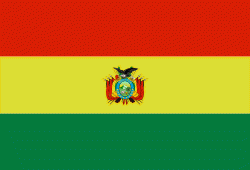Boliviano
Bs
The boliviano (sign: Bs ISO 4217 code: BOB) is the currency of Bolivia. It is divided into 100 cents or centavos in Spanish. Boliviano was also the name of the currency of Bolivia between 1864 and 1963. From April 2018, the manager of the Central Bank of Bolivia, Pablo Ramos, announced the introduction of the new family of banknotes of the Plurinational State of Bolivia, started with the 10 Bs note, and then gradually arrived to introduce the 200 Bs note, presented in April 2019. The new family of banknotes of the Plurinational State received several awards such as "the best banknotes in Latin America", was highlighted by its security measures, its aesthetics and its inclusion of prominent figures in Bolivian history, being among those who awarded the "Latin American High Security Printing Press Conference".Currencies in use before the current second boliviano include:
* The Spanish colonial real from the 16th to 19th centuries, with 8 reales equal to 1 peso and 16 reales equal to 1 escudo.
* The Bolivian sol from 1827 to 1864, replacing the Spanish real at par. 16 soles were equal to 1 Bolivian scudo, and 8 soles were equal to 1 boliviano.
* The first boliviano from 1864 to 1963, worth eight soles and divided into 100 centécimos (later centavos). The name bolivar was used for an amount of ten bolivianos.
* The peso boliviano (code ), from 1963 to 1986, worth 1,000 first bolivianos.
The second boliviano was introduced in 1987 at a rate of 1 boliviano = 1,000,000 pesos bolivianos.
Country
-
Bolivia
Bolivia, officially the Plurinational State of Bolivia, is a landlocked country located in western-central South America. It is bordered by Brazil to the north and east, Paraguay to the southeast, Argentina to the south, Chile to the southwest and Peru to the west. The seat of government and executive capital is La Paz, while the constitutional capital is Sucre. The largest city and principal industrial center is Santa Cruz de la Sierra, located on the Llanos Orientales (tropical lowlands), a mostly flat region in the east of the country.
The sovereign state of Bolivia is a constitutionally unitary state, divided into nine departments. Its geography varies from the peaks of the Andes in the West, to the Eastern Lowlands, situated within the Amazon basin. One-third of the country is within the Andean mountain range. With 1098581 km2 of area, Bolivia is the fifth largest country in South America, after Brazil, Argentina, Peru, and Colombia (and alongside Paraguay, one of the only two landlocked countries in the Americas), the 27th largest in the world, the largest landlocked country in the Southern Hemisphere, and the world's seventh largest landlocked country, after Kazakhstan, Mongolia, Chad, Niger, Mali, and Ethiopia.
